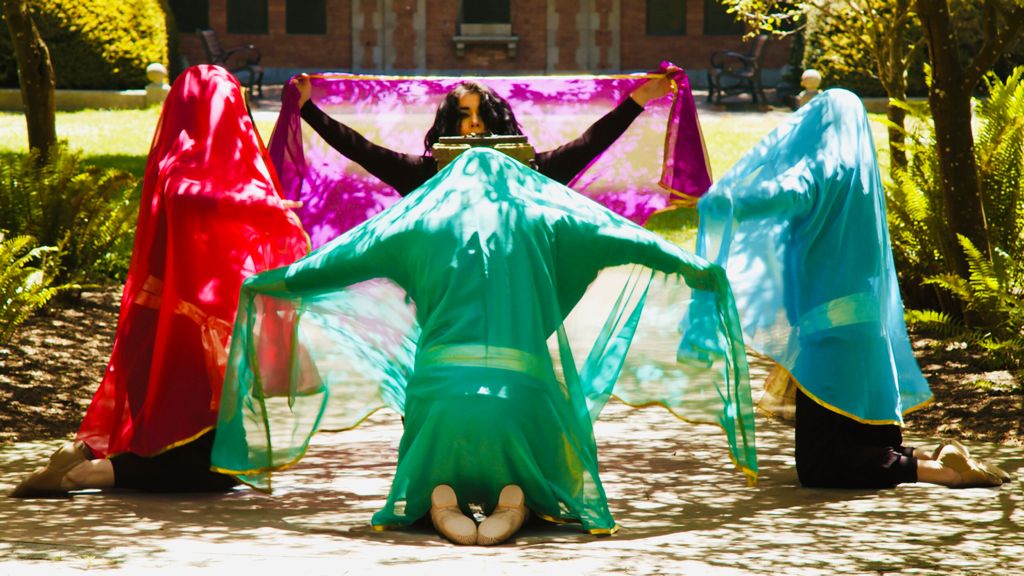
Photo by David Gaylord
[ID: In an outdoor space, dancers Parya Saberi, Rachel Duff, Janelle Rodriguez, and Tina Toy kneel facing each other in a small circle. They’re all wearing a dark top and pants with tan shoes. Each also has sheer, brightly colored fabric with gold trim draped over their heads and lifted by their arms.]
Last year, I graduated with a master’s in fine arts (MFA) in dance. This was my third terminal degree, and extra special to me because it fulfilled a lifelong goal and was totally different from anything I’d ever done before. But upon writing and creating my thesis paper and performance, I began feeling the anxiety of separation from my story, what I was sharing through my artistry, and what I was releasing into the world. It was a strange feeling but I can only compare it to a profound sadness of separation. Truthfully, I have never given birth to a human baby but I have talked to many friends and women who have told me about their intense depression after giving birth. This is how I felt in my own way. The intensity of the depression grew after graduating and the sadness remains with me to this day. It is often difficult to even talk about it because it seems silly to feel sad about being parted from one’s trauma. To someone who’s never experienced it, it may seem indulgent or frivolous to wallow in sadness after “birthing” art. In talking to other artists, I have come to realize that birthing one’s long-held emotions through art is traumatic. Post-artum depression is real. It can be paralyzing once a project is complete and can prevent future desires to create from the heart.

Unfortunately, I don’t have great solutions for dealing with this post-artum depression. But there are a few things that seem to help. First, I force myself to talk about it. I discuss among friends and in safe spaces. This allows me the chance for self-discovery and to explore what underlies my sense of longing and destitution. It has also allowed other artist-friends to open up about similar sentiments and acknowledge the lack of discussion around mental health challenges among artists. Second, I force myself to create. I make a conscious effort to get back to creating, even when my legs feel like lead, even as I flail around on the floor, and even if the end result is crap. I rent studio space, force myself to choreograph, take dance classes, and go to lots of performances. In many ways, I am trying to fill back my proverbial cup and keep my connection to dance any way possible. Third, and most importantly, I try to show myself compassion. I give myself space and grace. We are living in an arduous and crumbling world where progress is a mirage, art is devalued, democracy is a sham, and the patriarchy still has a stronghold over every part of our lives. In this environment kindness to oneself is key to relative sanity.
For those of you who have experienced what I have described, please know that you are not alone. The road ahead is difficult, but you and your art are precious and needed in the world. Art keeps us sane and balanced. Art keeps humanity human and it is art that will save us.
This article appeared in the Fall 2022 issue of In Dance.


